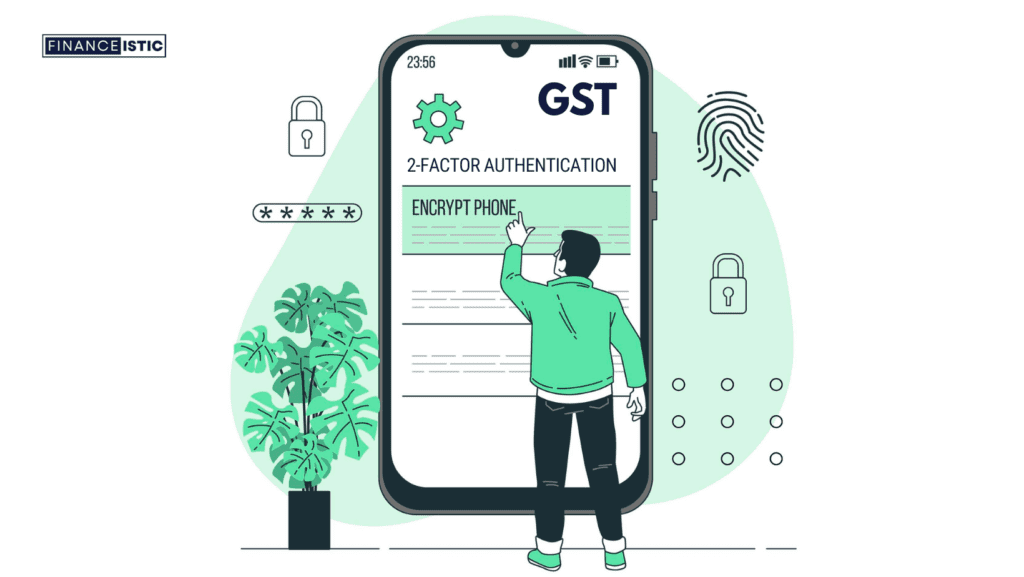A major change has been announced for taxpayers in an effort to strengthen the security measures of the Goods and Services Tax Network (GSTN) portal. The implementation of two-factor authentication in GST (2FA) is an essential step in providing a more secure and reliable login process. The advisory explains the important changes for taxpayers, the role of one-time passwords (OTPs), and the phased implementation.

Table of Contents
Advisory on 2-Factor Authentication in GST
The GSTN published Important Advisory No. 618 on 2-Factor Authentication in GST for Taxpayers on December 1, 2023, to increase login security on the GST system.
GSTN is launching 2-factor authentication in GST (2FA) for taxpayers to improve login security on the GST portal. The test deployment has been completed for the state of Haryana and is operating smoothly. The first phase of 2FA would cover Punjab, Chandigarh, Uttarakhand, Rajasthan, and Delhi. In the second phase, it is scheduled to be implemented in all states across India.
Taxpayers must submit a one-time password (OTP) after entering their user ID and password; the OTP will be delivered to their primary authorized signatory’s “mobile number and email id.”.
Taxpayers should keep their authorized signatory’s email and mobile number current on the GST Portal in order to receive the OTP communication. This OTP will only be requested if the taxpayer changes the system (desktop, laptop, or browser) and location.
The remedy would be implemented beginning December 1, 2023.
The advisory is available at: GST Portal.
Implications of 2-Factor Authentication in GST (2FA)
1. Improved security
- The primary goal of deploying 2FA is to make the GST portal more secure overall.
- A one-time password (OTP) adds an extra layer of security, making it difficult for hackers to get access to taxpayer accounts.
2. An organized implementation strategy
- The continuous implementation of new security measures, which began in Haryana and has since spread to Punjab, Chandigarh, Uttarakhand, Rajasthan, and Delhi, provides for controlled testing and implementation.
- It enables the authorities to address any potential issues or challenges prior to widespread deployment.
3. Regional Implementation Difficulties
- Different regions of the country may have varying amounts of technology infrastructure and digital literacy.
- The progressive implementation takes these geographical variations into account and allows for changes based on the unique demands and difficulties of each site.
4. Minimize unauthorized entry
- Because an additional authentication step via OTP is required in the event that login credentials are compromised, 2FA considerably reduces the risk of unauthorized access.
- It also aids in detecting fraudulent activities and safeguarding sensitive taxpayer information.
- The deadline for national implementation.
- The deadline for all taxpayers nationwide to comply with the 2FA standards is December 1, 2023, which marks the start of the second phase of nationwide implementation.
- This deadline emphasizes how critical it is to secure taxpayer data.
5. Expected First Interruptions
- Similar to any big system change, there may be some initial snags or difficulty as users adjust to the new authentication technique.
- During the transition period, the GSTN and appropriate authorities must be prepared to address any unanticipated challenges and provide assistance.
6. Long-term Impact on Cybersecurity Protection
- The implementation of 2FA is part of a bigger effort to increase banking sector cyber security protection.
- This long-term impact may help firms and taxpayers maintain trust in the security mechanisms put in place by tax authorities.
7. Awareness and Education for Users
- Taxpayers must be properly informed about the new authentication procedure as a result of the deployment of 2FA.
- It may be required to run awareness efforts and training sessions to ensure that users understand the value of two-factor authentication (2FA) and how to use OTPs for secure login.
8. Continuous observation and updates
- It is critical to monitor user input and system performance in order to detect and address any new security vulnerabilities.
- It may be necessary to refresh and improve the 2FA system on a regular basis in order to keep up with emerging cyber security threats.
9. Adoption and compliance
- Businesses and taxpayers are jointly responsible for ensuring that the new safety practices are followed.
- Businesses, taxpayers, and other stakeholders must collaborate for 2FA to be implemented properly, necessitating a smooth transition to the new authentication method.
Conclusion
The introduction of two-factor authentication by Team GSTN is aimed at encouraging taxpayers to adopt this increased security feature for the GST portal. A more secure tax-filing experience will be provided by the progressive implementation, updated contact information, and OTP use. Taxpayers may help to create a secure and smooth digital environment by being aware and taking active steps to manage their personal information. The planned implementation on December 1, 2023, is a critical turning point in strengthening the GSTN portal’s security.
Frequently Asked Questions (FAQ)
The GST e-invoice system has been modified to require two-factor authentication for all taxpayers with an annual aggregate turnover (AATO) greater than Rs. 20 crores. It will become effective on November 20th, 2023.
The OTP helps to prevent online fraud. It is a secure mechanism to confirm that the user signing in is a trusted user.
The primary goal of adopting 2-Factor Authentication (2FA) in the e-Waybill and e-Invoice System is to strengthen the login process and improve the overall security posture of the system. It provides an additional degree of security against unauthorized access to sensitive data and financial transactions.
Taxpayers with an Annual Aggregate Turnover (AATO) of more than Rs 100 crore must comply with the e-Waybill/e-Invoice System’s mandatory 2-Factor Authentication (2FA) requirement. This requirement is effective as of August 20, 2023. Small taxpayers with AATO of up to Rs 100 crore are not covered currently.